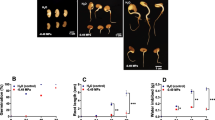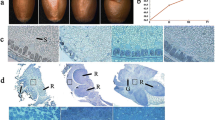Abstract
This study was conducted to obtain basic information on protein profile changes by artificial aging in soybean seeds. Seed proteins were extracted using the protamine sulfate precipitation method, which improves the detection of low-abundance proteins (LAPs) by depleting the major seed storage proteins . Isolated proteins were separated by high-resolution two-dimensional gel electrophoresis (2-DE), and differentially modulated protein spots were identified by MALDI-TOF/TOF. A total of 33 differential proteins were identified of which 31 and 2 showed decreased and increased abundances, respectively. Functional annotation of the identified proteins revealed that proteins were mainly associated with primary metabolism (55%) and response to stimulus (20.9%). Proteins with increased abundance were associated with nutrient reservoir activity (spots 5, 10), while the decreased abundance proteins were mainly involved in the primary metabolism such as carbohydrate metabolic process (spots 1–3, 11), protein folding (spots 6–9, 33), glucose metabolic process (spot 25) oxidoreductase activity (spots 19–24), UDP-glucose pyrophosphorylase activity (spots 12, 13). These results provide information about proteome changes, especially, LAPs during artificial seed aging treatment.




Similar content being viewed by others
References
Agrawal GK, Hajduch M, Graham K, Thelen JJ (2008) In-Depth investigation of the soybean seed-filling proteome and comparison with a parallel study of rapeseed. Plant Physiol 148:504–518
Anderson JD, Baker JE (1983) Deterioration of seeds during aging. Phytopathology 73:321
Bailly C, Benamar A, Corbineau F, Côme D (1996) Changes in malondialdehyde content and in superoxide dismutase, catalase and glutathione reductase activities in sunflower seeds as related to deterioration during accelerated aging. Physiol Plant 97:104–110
Bailly C, El-Maarouf-Bouteau H, Corbineau FF (2008) From intracellular signaling networks to cell death: the dual role of reactive oxygen species in seed physiology. C R Biol 331:806–814
Bentsink L, Jowett J, Hanhart CJ, Koornneef M (2006) Cloning of DOG1, a quantitative trait locus controlling seed dormancy in arabidopsis. Proc Natl Acad Sci USA 103:17042–17047
Boston RS, Viitanen PV, Vierling E (1996) Molecular chaperones and protein folding in plants. Plant Mol Biol 32:191–222
Da Silva PMFR, Eastmond PJ, Hill LM, Smith AM, Rawsthorne S (1997) Starch metabolism in developing embryos of oilseed rape. Planta 203:480–487
Dong K, Zhen S, Cheng Z, Cao H, Ge P, Yan Y (2015) Proteomic analysis reveals key proteins and phosphoproteins upon seed germination of wheat (Triticum aestivum L.). Front Plant Sci 6:1017
Egli DB, TeKrony DM, Heitholt JJ, Rupe J (2005) Air temperature during seed filling and soybean seed germination and vigor. Crop Sci 45:1329–1335
Friedman M (1996) Nutritional value of proteins from different food sources. A review. J Agric Food Chem 44:6–29
Gelebart P, Opas M, Michalak M (2005) Calreticulin, a Ca2+-binding chaperone of the endoplasmic reticulum. Int J Biochem Cell Biol 37:260–266
Gupta R, Kim SW, Wang Y, Agrawal GK, Rakwal R, Kim SG, Lee BW, Ko JM, Baek IY, Bae DW, Kim ST (2015a) Comparative investigation of seed coats of brown- versus yellow-colored soybean seeds using an integrated proteomics and metabolomics approach. Proteomics 15:1706–1716
Gupta R, Wang Y, Agrawal GK, Rakwal R, Jo IH, Bang KH, Kim ST (2015b) Time to dig deep into the plant proteome: a hunt for low-abundance proteins. Front Plant Sci 6:22
Gupta R, Min CW, Wang Y, Kim YC, Agrawal GK, Rakwal R, Kim ST (2016) Expect the unexpected enrichment of “Hidden Proteome” of seeds and tubers by depletion of storage proteins. Front Plant Sci 7:1–7
Hartl FU (1996) Molecular chaperones in cellular protein folding. Nature 381:571–579
Jia XY, Xu CY, Jing RL, Li RZ (2008) Molecular cloning and characterization of wheat calreticulin (CRT) gene involved in drought-stressed responses. J Exp Bot 59:739–751
Jia XY, He LH, Jing RL, Li RZ, Mao XG, Wang JP, Chang XP (2009) Calreticulin: conserved protein and diverse functions in plants. Physiol Plant 136:127–138
Khan M, Takasaki H, Komatsu S (2005) Comprehensive phosphoproteome analysis in rice and identification of phosphoproteins responsive to different hormones/stresses. J Proteom Res 4:1592–1599
Kibinza S, Vinel D, Côme D, Bailly C, Corbineau F (2006) Sunflower seed deterioration as related to moisture content during ageing, energy metabolism and active oxygen species scavenging. Physiol Plant 128:496–506
Kim YJ, Lee HM, Wang Y, Wu J, Kim SG, Kang KY, Park KH, Kim YC, Choi IS, Agrawal GK, Rakwal R, Kim ST (2013a) Depletion of abundant plant RuBisCO protein using the protamine sulfate precipitation method. Proteomics 13:2176–2179
Kim YJ, Lee S, Lee HM, Lee BW, Ha TJ, Bae DW, Son BY, Kim YH, Baek SB, Kim YC, Kim SG, Kim ST (2013b) Comparative proteomics analysis of seed coat from two black colored soybean cultivars during seed development. Plant Omics 6:456–463
Kim YJ, Wang Y, Gupta R, Kim SW, Min CW, Kim YC, Park KH, Agrawal GK, Rakwal R, Choung MG, Kang KY, Kim ST (2015) Protamine sulfate precipitation method depletes abundant plant seed-storage proteins: a case study on legume plants. Proteomics 15:1760–1764
Kim SW, Gupta R, Lee SH, Min CW, Agrawal GK, Rakwal R, Kim JB, Jo IH, Park SY, Kim JK, Kim YC, Bang KH, Kim ST (2016) An integrated biochemical, proteomics, and metabolomics approach for supporting medicinal value of panax ginseng fruits. Front Plant Sci 7:994
Mahjabin Bilal S, Abidi AB (2015) Physiological and biochemical changes during deed deterioration: a review. Int J Recent Sci Res 6:3416–3422
Messina MJ (1999) Legumes and soybeans: overview of their nutritional profiles and health effects. Am J Clin Nutr 70:439–450
Min CW, Gupta R, Kim SW, Lee SE, Kim YC, Bae DW, Han WY, Lee BW, Ko JM, Agrawal GK, Rakwal R, Kim ST (2015) Comparative biochemical and proteomic analyses of soybean seed cultivars differing in protein and oil content. J Agric Food Chem 63:7134–7142
Murata M, Tsuchiya T, Roos EE (1984) Chromosome damage induced by artificial seed aging in barley. Theor Appl Genet 67:161–170
Murthy UMN, Kumar PP, Sun WQ (2003) Mechanisms of seed ageing under different storage conditions for Vigna radiata (L.) Wilczek: lipid peroxidation, sugar hydrolysis, Maillard reactions and their relationship to glass state transition. J Exp Bot 54:1057–1067
Nagel M, Kodde J, Pistrick S, Mascher M, Börner A, Groot SPC (2016) Barley seed aging: genetics behind the dry elevated pressure of oxygen aging and moist controlled deterioration. Front Plant Sci 7:388
Natarajan SS, Xu C, Bae H, Caperna TJ, Garrett WM (2006) Characterization of storage proteins in wild (Glycine soja) and cultivated (Glycine max) soybean seeds using proteomic analysis. J Agric Food Chem 54:3114–3120
Pandey G, Reddy MK, Sopory SK, Lata Singla-Pareek S (2002) Calcium homeostasis in plants: role of calcium binding proteins in abiotic stress tolerance. Indian J Biotechnol 1:135–157
Parkhey S, Naithani SC, Keshavkant S (2012) ROS production and lipid catabolism in desiccating Shorea robusta seeds during aging. Plant Physiol Biochem 57:261–267
Plaxton WC (1996) The organization and regulation of plant glycolysis. Annu Rev Plant Biol 47:185–214
Prieto-Dapena P, Castano R, Almoguera C, Jordano J (2006) Improved resistance to controlled deterioration in transgenic seeds. Plant Physiol 142:1102–1112
Qi Q, Kleppinger-Sparace KF, Sparace SA (1995) The utilization of glycolytic intermediates as precursors for fatty acid biosynthesis by pea root plastids. Plant Physiol 107:413–419
Qiu Y, Xi J, Du L, Poovaiah BW (2012) The function of calreticulin in plant immunity: new discoveries for an old protein. Plant Signal Behav 7:907–910
Rajjou L, Lovigny Y, Groot SPC, Belghazi M, Job C, Job D (2008) Proteome-wide characterization of seed aging in arabidopsis: a comparison between artificial and natural aging protocols. Plant Physiol 148:620–641
Scarpeci TE, Zanor MI, Valle EM (2008) Investigating the role of plant heat shock proteins during oxidative stress. Plant Signal Behav 3:856–857
Shackelford GS, Regni CA, Beamer LJ (2004) Evolutionary trace analysis of the α-D-phosphohexomutase superfamily. Protein Sci 13:2130–2138
Sharma S, Kaur A, Bansal A, Gill BS (2013) Positional effects on soybean seed composition during storage. J Food Sci Technol 50:353–359
Sung D, Kaplan F, Guy CL (2001) Plant Hsp70 molecular chaperones: protein structure, gene family, expression and function. Physiol Plant 113:443–451
Torres RM, Vieira RD, Panobianco M (2004) Accelerated aging and seedling field emergence in soybean. Sci Agric 61:476–480
Wang W, Vinocur B, Shoseyov O, Altman A (2004) Role of plant heat-shock proteins and molecular chaperones in the abiotic stress response. Trends Plant Sci 9:244–252
Wang L, Ma H, Song L, Shu Y, Gu W (2012) Comparative proteomics analysis reveals the mechanism of pre-harvest seed deterioration of soybean under high temperature and humidity stress. J Proteom 75:2109–2127
Xin X, Lin XH, Zhou YC, Chen XL, Lu XX (2011) Proteome analysis of maize seeds: the effect of artificial ageing. Physiol Plant 143:126–138
Yin X, He D, Gupta R, Yang P (2015) Physiological and proteomic analyses on artificially aged Brassica napus seed. Front Plant Sci 6:112
Acknowledgements
This work was supported by a grant from the National Agenda Programs for Agricultural R&D (PJ01004602201601), Rural Development Administration (RDA), Republic of Korea.
Author information
Authors and Affiliations
Corresponding author
Additional information
Cheol Woo Min and Yu Ji Kim have contributed equally.
Electronic supplementary material
Below is the link to the electronic supplementary material.
Rights and permissions
About this article
Cite this article
Min, C.W., Kim, Y.J., Gupta, R. et al. High-throughput proteome analysis reveals changes of primary metabolism and energy production under artificial aging treatment in Glycine max seeds. Appl Biol Chem 59, 841–853 (2016). https://doi.org/10.1007/s13765-016-0234-z
Received:
Accepted:
Published:
Issue Date:
DOI: https://doi.org/10.1007/s13765-016-0234-z




